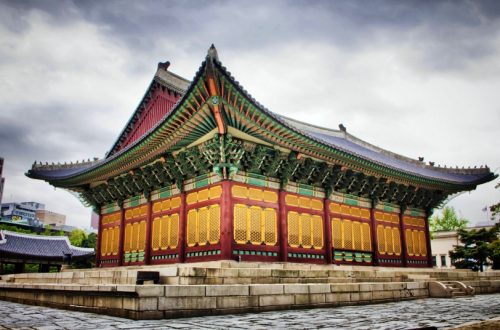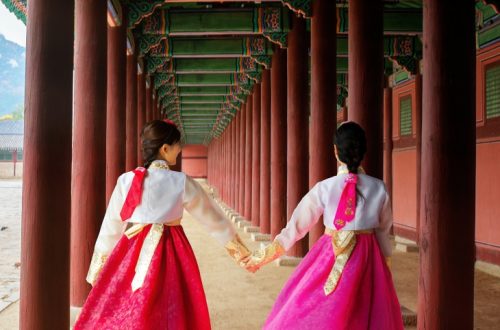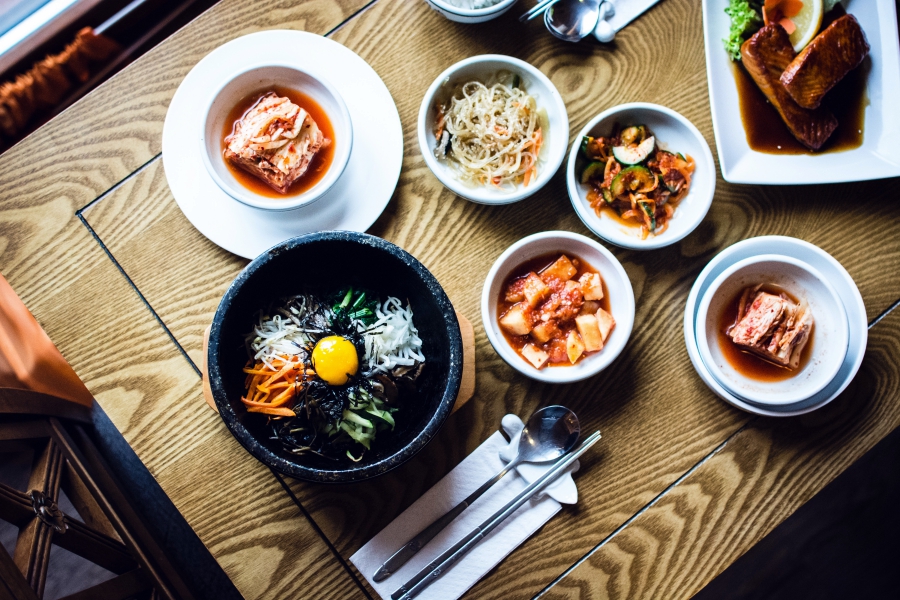
Top Korean Foods You Should Try
Korea Foods are very wealthy. They are colorfully made and eye-catching too. For a travel to Korea, it is a must to try at least 10 of the below signature Korean Dishes
Chimaek
Chimaek is a great pairing of Korean fried chicken and beer. This glorious combination is perfect for those who are spending an evening in one of South Korea’s vibrant cities or weekenders.
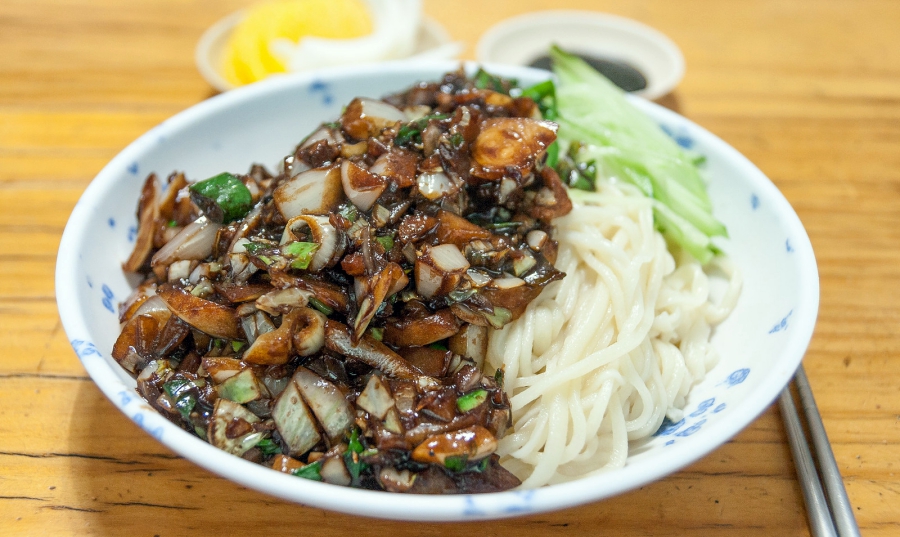
Jjajangmyeon
Are you in South Korean for its top luscious dishes? Jjajangmyeon is one of them. It consists of noodles that are topped with diced pork, a thick sauce made of chunjang and vegetables. It is a favorite to Korean locals. Most families eat it at least once a week.

Kimchi
Kimchi is probably the most iconic Korean Food which appears in many TV shows and exported worldwide. It is made by preserving fermented cabbage in a bed of ginger, pepper, garlic and scallion, this beloved spicy is common in most Korean eateries. There are of three types including red cabbage kimchi, Yeolmumul kimchi and ggakdugi.
There are many dishes made with Kimchi you should try and Vegetarian Kimchi fried Rice is one of them !
Samgyeopsal
Also known as grilled pork belly, Samgyeopsal is a must for anyone who loves Korean Cuisine. It is often served with perilla leaves, lettuce, raw garlic kimchi and sliced onions.
Kimchi Stew
This is one of the Korean dishes that are similar to western stew. With this, usually, red cabbage kimchi is chopped and cooked with cellophane noodles, tuna, pork, tofu and other vegetables.

Bibimbap
Bibimbap means mixed rice – one of the most popular Korean Foods. Once you make an order for it, expect to be served with a bowl of warm rice with seasoned vegetables, sliced meat, a raw or fried egg, chili pepper paste and soy sauce. It used to be a dish for the Korean royalty, but it’s now available for everyone.
Gimbap
Once you combine ground beef, sweet pickled radish, rice, sautéed vegetables, all rolled and wrapped in a sheet of laver seaweed, the result is what we call Gimbap. Sliced into bite-sized circles, this staple is liked for its strong taste.
Army Stew
This dish dates back to the aftermath of the Korean War. It consists of American cheese, instant noodles, assorted vegetables, tteok, Spam and Sausages.

Tteokbokki
Tteokbokki is amongst the famed street foods that epicures like to start with. It is made up of sliced rice cakes that are cooked with fish cakes and scallions in a spicy sauce mixed with chilli or black soybean paste.
Gopchang
When you talk about South Korea’s best dishes, most travelers know Kimchi, but Gopchang is another secret to reveal. These are often small intestines (from cattle or pigs) that are chopped into rounded sections and cooked into soups or grilled. Don’t miss to taste the awesome grilled Gopchang.
Hangover stew
Made from a beef broth with cabbage, chunks of congealed ox blood and bean sprouts, this dish has all the spices to relieve you from hangover after a night of heavy boozing.
Soft Tofu Stew
A mixture of clams, soft tofu and an egg results into Soft Tofu stew, one of the staples that enchant culinary adventurers in South Korea. During preparation, the soft tofu breaks into chunks to hold the flavor of the clam, a cracked egg is added and boiled by use of the traditional earthenware pot.
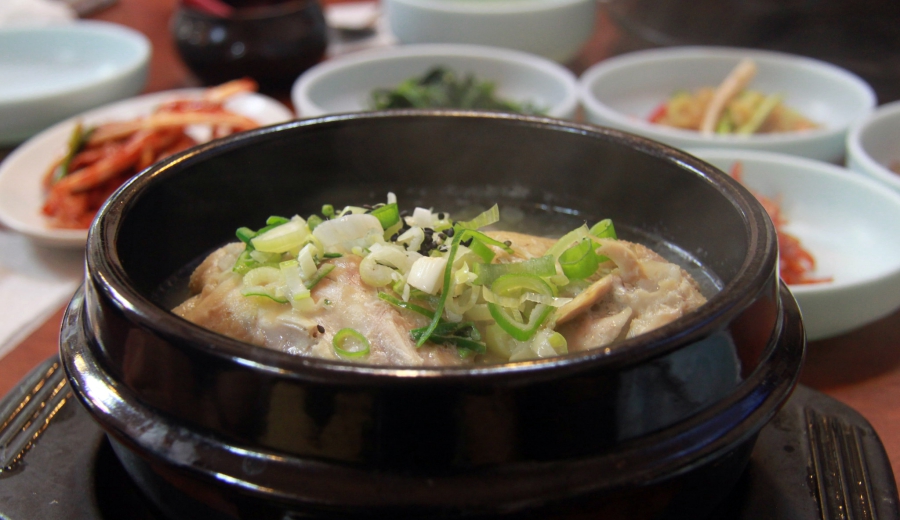
Samgyetang
Composed of young chicken stuffed with rice, garlic, ginseng and jujube, Samgyetang makes for a warm soup best for hot summer days. It is very easy to make, good for body health and delicious.
Doenjang
Derived from fermented soybeans and salt, Doenjang is inclusive of Korea’s most used pastes. It’s featured in most foods and can spice up some dishes in a way that other spices can’t. Try it in bibimbap.
Gamjatang
Since it’s an alternative to hangover stew, it is no surprise that the demand for this hearty dish is very high in the morning hours. Gamjatang is composed of scallions, ground perilla seed, bits of cooked pork and potatoes. It differs itself with an excellent taste of the perilla seeds.
Haemul Pajeonv
Made from wheat flour, rice flour, scallions and eggs, Haemul Pajeon is amongst the most devoured Korean foods. Other stuff that can be added to this pancake includes pork, beef, kimchi and variety of seafood such as Shellfish, cuttlefish and more. It makes for a superb meal when accompanied by Korean rice wines.
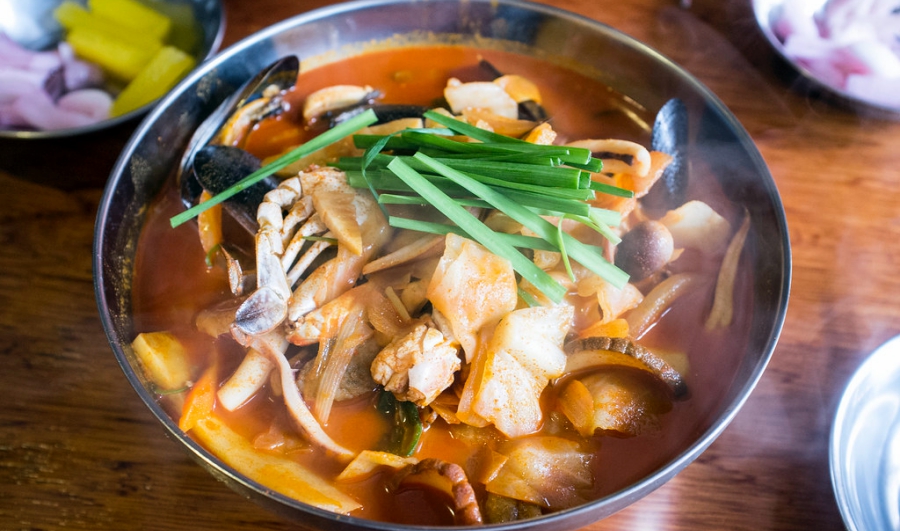
Jjambbong
Flavored by onions and chili oil, Jjambbong is a Korean noodle soup. Garlic, Korean zucchini, carrots, mussels, pork, squid and cabbages add to the list of ingredients used by most chefs during its preparation. It is mostly served with vegetables.
Sundae
Sundae is common almost on every street in South Korea. It is a type of sausage and usually made by steaming small cow and pig intestines that are stuffed with various ingredients.
Kongguksu
For vegetarians, Kongguksu is one of the best dishes for you. Served in a cold soy milk broth, this dish comprises soup made from ground soybeans and noodles. It is nutritious and best to rely on in the summer days.
Kalguksu
Not like other noodle soups, Kalguksu is traditionally made with handmade and knife-cut noodles. To make it yummier, most eateries in South Korea add in sliced pumpkins, chicken, different seafood and mushrooms.
Ox Bone Soup
Nothing is more appealing than tasting a hot ox bone soup on a cold winter day. The mixture (seolleongtang broth) contains finely chopped scallions, strips of meat and noodles complemented by rice or Kkakdugi kimchi.
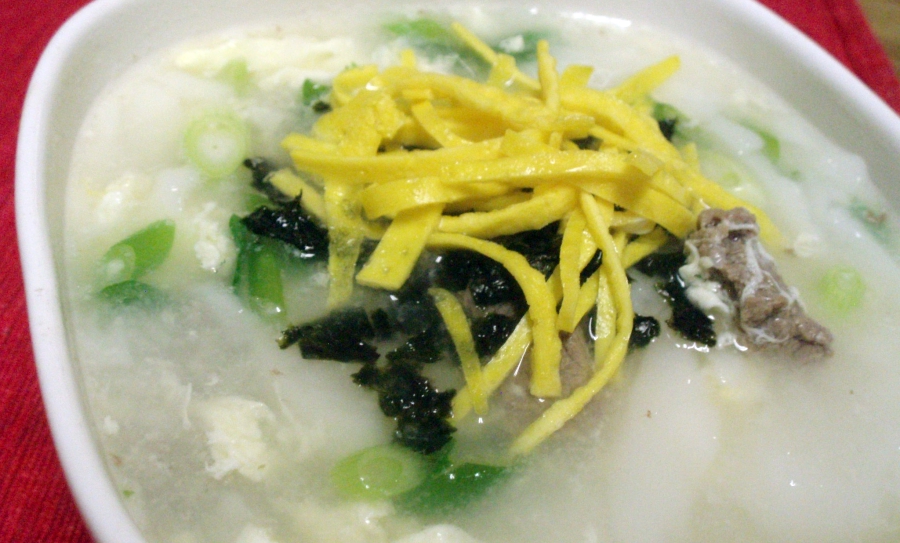
Tteokguk
Tteokguk is a traditional meal and was eaten only on the Korean New Year celebrations, but it’s now available all year round. It consists of eggs, dried laver seaweed and slices of oval rice cakes.
Doenjang jjigae
When you ask most locals or culinary adventurers of their most beloved Korean foods, Doenjang jjigae can’t miss. The main ingredients used in this stew are mushrooms, seafood, green peppers and tofu. You can add kimchi and rice to make a complete meal for your lunch.
Galbi
Galbi is a type of gui in Korean cuisine. Its preparation includes thick slabs of meat immersed in soy sauce, sugar, chopped garlic and grilled for some time. Beef galbi can be used to make some of the most delicious soups in Asian foods.
Chuncheon dakgalbi
A food trip to South Korea isn’t complete without the piquant Chuncheon dakgalbi. This tasty dish consists of chicken chunks marinated in chili paste and fried with cabbages, carrots, slices of sweet potato and tteok in a large pan.

Bossam
For pork lovers, Bossam is a dish you must not miss while in South Korea. If it is your target expect to be served with sliced pieces of steamed pork that are wrapped in a leaf of lettuce and smeared with chili or soybean paste. On this meat, you can add on the spicy radish salads, raw garlic and kimchi.
Agujjim
As far as food, South Korea is known for its vegetarian dishes like Kimchi, but it also has something to offer for Seafood enthusiasts. One of the seafood dishes to start with is Agujjim. Bright reddish in color, Agujjim consists of anglerfish braised on a bed of dropwort and bean sprout.
Gyeranjjim
Gyeranjjim adds to the list of vegetarian dishes in South Korea. This spongy and pale yellow cake is more luscious when eaten with spicy foods. It looks yummier when made with carrots, zucchini, diced mushrooms and sesame seeds dredged on top.
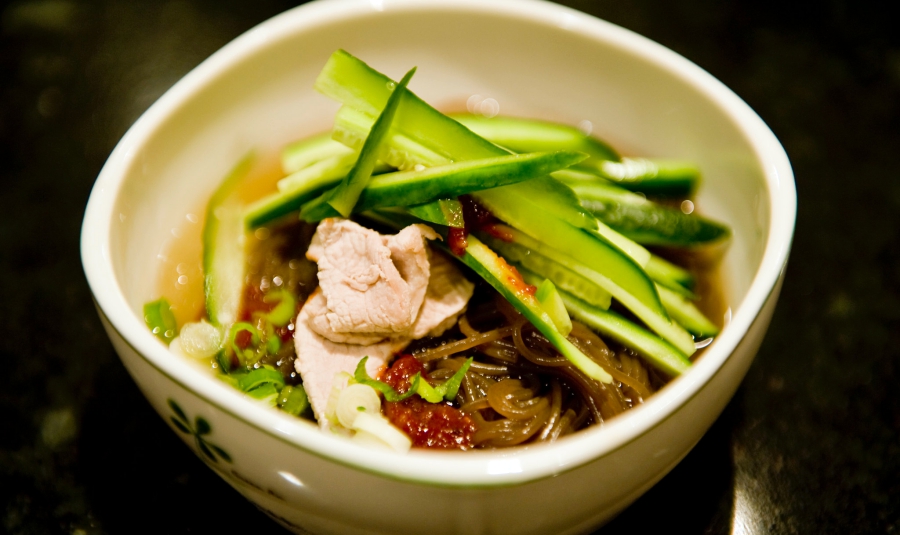
Naengmyeon
More common in summer, Naengmyeon consists of buckwheat noodles that are topped with cucumber, eggs, slivers of radish and seasoned with vinegar and gyeoja.
Japchae
Japchae is mostly served as a side dish. It comes with cellophane noodles, vegetables sauteed in soy sauce, pork and other recipes such as carrots, onions, leeks, spinach and mushrooms.
Dubu kimchi
Dubu kimchi is a mixture of stir-fried kimchi and tofu. It’s served with fermented tangy baechu-kimchi and pork. This dish makes for a perfect match with soju or makgeolli, that’s why it is common in South Korea’s traditional bars and restaurants.
Hobakjuk
Don’t forget to taste a bowl of porridge made from pumpkin. Boiled and blended with rice flour, this yellow-orange juk is served as an appetizer before meals. It is healthy and more beneficial for those having intestinal problems.
Dotorimuk
This is often served cold with a topping of chopped leeks and soy sauce. Most foodies love Dotorimuk for its appetizing spices, and it is vegan-friendly.
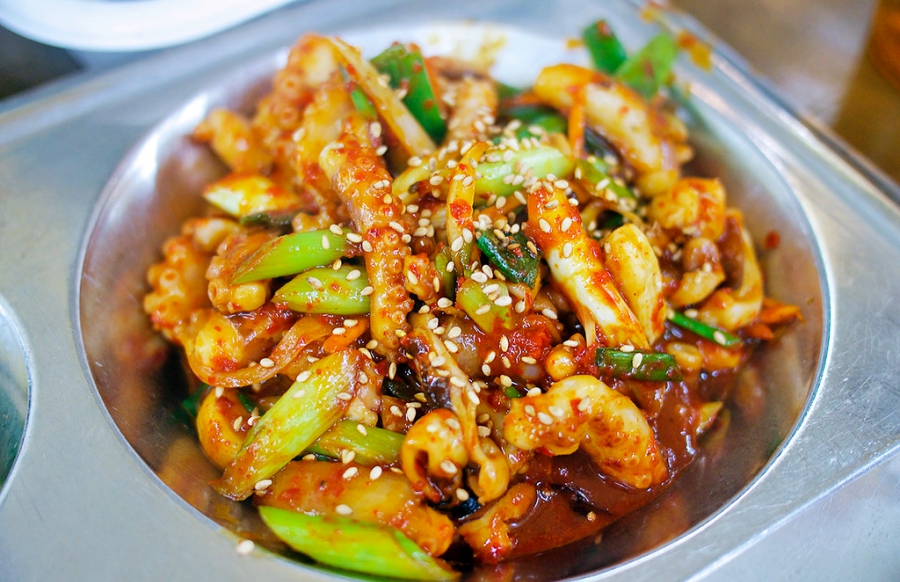
Nakji bokkeum
Nakji bokkeum is usual in most South Korea’s restaurants and a must for those taking food tours in the country. Usually, chopped octopus and vegetables such as green onions, cabbage and carrots are immersed in soy sauce, garlic, sugar and the result is this palatable dish that is favorite to most foodies.
Bingsu
With this summer dessert, tteok and sweetened red beans are served on a bed of shave ice along with misutgaru, syrup, ice cream, corn flakes and condensed milk.



